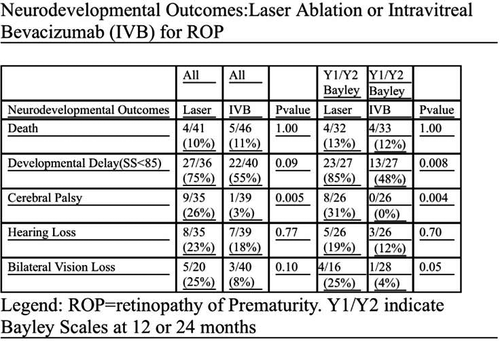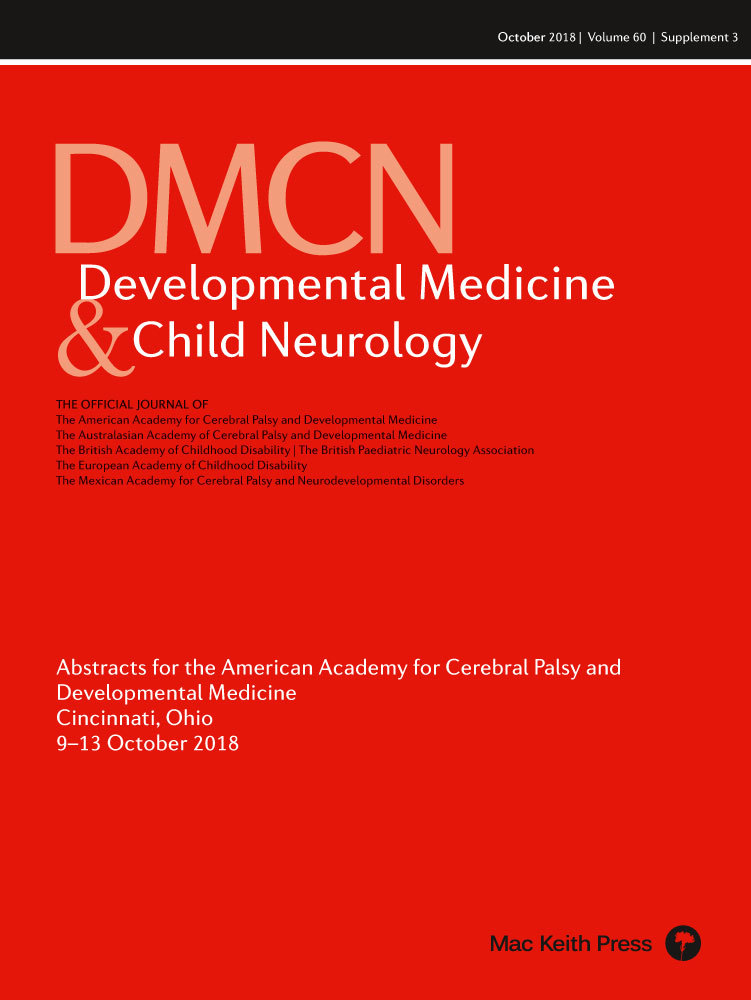Neurodevelopmental outcomes after extreme prematurity comparing bevacizumab to laser surgery for type 1 retinopathy of prematurity
H3
C Peyton1, S Rodriquez1, B Andrews1, M Schreiber1, K Wroblewski2, M Msall1
1 University of Chicago, Chicago, IL, USA; 2University of Chicago Health Services, Chicago, IL, USA
Background and Objective(s): Laser treatment for retinopathy of prematurity (ROP) improves visual structural and functional outcomes, destroys retinal tissue, and does not guarantee favorable visual outcomes. An antivascular endothelial growth factor (VEGF) medication, intravitreal bevacizumab (IVB), may be a less destructive. In the Bevacizimab Eliminates the Angiogenic Threat of Retinopathy of Prematurity (BEAT-ROP) trial(NCT00622726), IVB compared to laser therapy, reduced the rate of recurrence of type1 ROP and high myopia.. Our purpose was to evaluate neurodevelopmental outcomes among all treated infants at our institution , where eyes with posterior Type 1 ROP received laser treatment before publication of BEAT-ROP RCT in 2011. After 2011 these infants were treated with IVB .
Study Design: Inclusion criteria included BW < 1500 g and GA < 31 weeks. Retrospective chart reviews identified 41 infants treated with laser ablation and 46 with IVB between 2006 and 2016. Neurodevelopmental outcomes included developmental delay(Bayley <85), cerebral palsy, hearing loss, and bilateral visual loss worse than 20/200.. The generalized movement assessment (G)was performed at 12 weeks post term age-equivalent (PTA)after certification by the Prechtl Trust in 2013. Bayley-III scales were performed at 12 months or 24 months PTA .
Study Participants & Setting: All treated infants from a regional perinatal network involving 19,000 births were seen in follow-up. The mean gestation age was 24.9 weeks, birth weight 695 G, African American Race 37%, Male 60%. These infants experienced many complications including BPD 61%, IVH III/IV 23%, PVL 16%, NEC 33%, Sepsis 60%, and initial hospital length of stay of 145 days.
Materials/Methods: Neurodevelopmental outcomes included developmental delay(Bayley <85), cerebral palsy, hearing loss, and bilateral visual loss worse than 20/200.. The generalized movement assessment (G)was performed at 12 weeks post term age-equivalent (PTA)after certification by the Prechtl Trust in 2013. Bayley-III scales were performed at 12 months or 24 months PTA .
Results: Bayley-III standard scores for IVB (n = 9) and laser (n = 13) groups were not statistically significant for cognitive (77.0, 76.7); language (83.8, 84.5) and ; motor (81.2 ,77.3)outcomes respectively. . Among all patients, neurodevelopmental outcomes trends were more favorable for IVB than laser. G was available for 19 infants who were treated with IVB. Of those, 6 (31%) had absent movements and , 5(26%) infants had sporadic movements.. Using absent movements on G testing as a predictor for CP, the expected rate of CP in the IVB group would be 6/19 (31%), similar to the rate of CP in the laser group with unrestricted follow-up (p = 0.56). Assuming that presence of fidgety movements at 12 weeks PTA predicts low risk for motor or cognitive delay, the anticipated proportion without delay in the IVB group was 8/19 (42%).
Conclusions/Significance: The results of our time series analysis are reassuring that IVB treatment is not associated with increased risk of adverse neurodevelopmental outcomes. Although initial results suggest CP is less common with IVB, this relationship appears to have been confounded by shorter length of follow-up. Future prospective studies are necessary to further evaluate the systemic implications of IVB treatment for ROP. Both ROP and Gs offer early biomarkers that will be useful to improve long term visual, motor, and cognitive development in high risk extremely preterm survivors.
Acknowledgements: This study was supported in part by a grant from by Illinois Society to Prevent Blindness Grant





